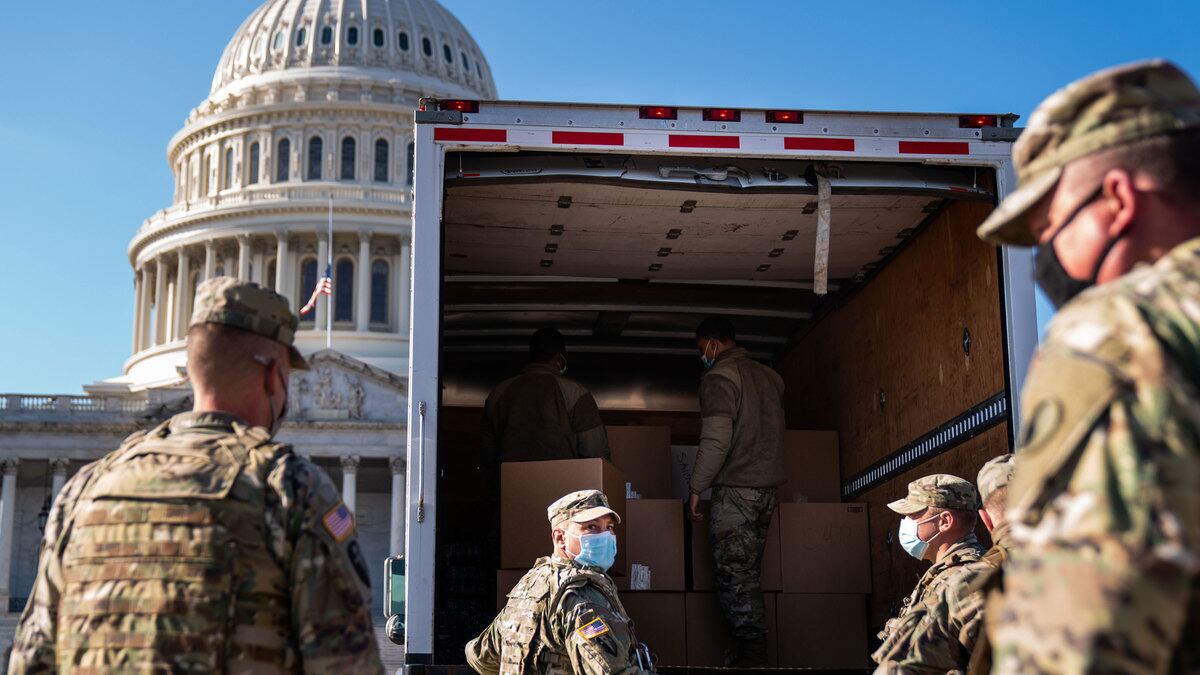Senior Pentagon officials denied an early December request to vaccinate the National Guard troops tapped to secure Washington during the inauguration, according to two officials familiar with the matter.
Those sources said the request, made by officials in charge of planning the event, was rejected because most of the guardsmen called to help protect the inauguration fell outside of the first tier of the Department of Defense’s population schema for the COVID-19 vaccine. Despite the rebuff, inauguration event planners continued to press the issue, raising fears about the spread of the virus within the Capitol campus and among attendees, particularly if protesters at the event did not wear masks, officials said.
One individual involved with the planning said senior officials at the Pentagon pushed back against the vaccination idea primarily because they were worried about muddling the department’s prescribed vaccination playbook—that the process would divert doses away from those in the first wave of distribution. Now National Guard spokespeople say they don’t know how many of the guardsmen have been vaccinated. Another official familiar with the matter, however, said some troops did receive their first shot when they showed up for duty at the Capitol. Meanwhile, dozens of National Guard troops working to help protect the inauguration have tested positive for the virus, according to a report by the Military Times.
“What we are doing is screening incoming Guard men and women according to CDC guidelines. This was done upon departure from their individual states and upon arrival to the D.C. Armory,” one National Guard spokesperson told The Daily Beast, adding that temperature checks and screening questions are in place and that masks and social distancing are required “where the mission allows.”
“It’s ridiculous that we’re asking these troops to come in and protect people, and we’re not making sure they’re protected themselves,” said one U.S. official helping with the inauguration planning. “This shouldn’t have happened.”
The decision not to vaccinate the National Guard troops before their arrival at the Capitol underscores the extent to which the federal government, as well as states across the country, has struggled to navigate the intricate COVID-19 vaccine distribution process and scale immunization.
Days after the initial doses were shipped by Pfizer in the second week of December, states reported receiving less vaccine doses than anticipated. Officials working with Operation Warp Speed, a public-private partnership to fast-track a vaccine, rebuffed the states’ concerns, saying a slight shift in the allocation schedule had caused a minor delay but that more vaccine doses were on the way. As the weeks rolled by, vaccination rates remained low throughout the U.S., including within the Department of Defense.
One official familiar with the Pentagon’s distribution said Walter Reed Medical Center, in particular, lagged in administering the doses it had received in the first several weeks of the vaccine rollout. And experts began to worry about the national vaccination rate, emphasizing that something needed to be done quickly to scale not just distribution but also immunization.
In the initial days of the vaccine distribution, state officials—and officials within the Pentagon— closely followed the recommendations from the Centers for Disease Control that detailed how officials should go about doling out doses, including who should receive the vaccine first. It wasn’t until earlier this month, after vaccine rates stalled, that the federal government began to discuss redefining the CDC’s guidelines in an effort to push states to distribute the vaccine more freely.
In the first week of January, as The Daily Beast previously reported, officials working on the vaccine and its distribution met at Camp David to discuss the importance of scaling vaccination nationwide more quickly. The idea was to tell states to hand out doses that were set to expire on the shelf to anyone who wanted them even if they fell outside the first recommended CDC wave.
Then, a week later, on Jan. 12, the federal government, in tandem with the Biden COVID-19 team, told states to open up the vaccines to everyone in America older than age 65, as well as anyone younger who has a pre-existing condition that could make them more vulnerable to the coronavirus. On top of widening access, the government said it would no longer hold back doses for the second shot of the vaccine and that states should instead try to administer all available doses as quickly as possible.
But by that time—days after the mob attacked the Capitol and less than a week before the inauguration—officials at the Pentagon determined it was too late to begin vaccinating all of the National Guard troops called up. There were simply too many of them. And even if the department began vaccinating those called up for inauguration, troops would not be protected by Jan. 20. Both the Pfizer and Moderna vaccine are administered in two doses weeks apart from one another, and experts say an individual is not protected until seven days after the second dose.
The officials familiar with the conversations about vaccinating the National Guard said discussions about how to protect the troops during their time serving for the inauguration continued throughout December and January. The Pentagon finally settled on the decision to begin administering the vaccine to troops in the Capitol complex anyway, even if the doses do not protect them during the inauguration events.
“The idea is to speed up vaccination,” one official working with the Pentagon’s vaccination program said. “And we have all these people in one place. It’s a perfect setting to make sure we give all of them their shots, whether that be their first or second.”
The Pentagon initially approved 6,000 National Guard troops to deploy to the Capitol to help protect the inauguration. That number quickly swelled to 25,000, with troops deploying from all 50 states and three territories.






